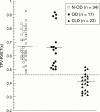Doppler assessment of pulmonary artery pressure in neonates at risk of chronic lung disease
- PMID: 9279178
- PMCID: PMC1720660
- DOI: 10.1136/fn.77.1.f23
Doppler assessment of pulmonary artery pressure in neonates at risk of chronic lung disease
Abstract
Aim: To evaluate the pulmonary artery pressure (PAP) change in very low birth-weight (VLBW) infants at risk of chronic lung disease (CLD).
Methods: The time to peak velocity:right ventricular ejection time (TPV:RVET) ratio calculated from the pulmonary artery Doppler waveform, which is inversely related to PAP, was used. The TPV:RVET ratio was corrected for different heart rate (TPV:RVET(c)). Seventy three VLBW infants studied on days 1, 2, 3, 7, 14, 21 and 28 were enrolled for the analysis.
Results: Twenty two infants developed CLD with a characteristic chest radiograph at day 28. Fifty one did not, of whom 17 were oxygen dependent on account of apnoea rather than respiratory disease, and 34 were non-oxygen dependent. The TPV:RVET(c) ratio rose progressively in all three groups over the first three days of life, suggesting a fall in PAP. In the oxygen and non-oxygen dependent groups, the mean (SD) ratio rose to 0.53 (0.09) and 0.57 (0.09), respectively, on day 7, then remained relatively constant thereafter. The CLD group rose more slowly after day 3 and had a significantly lower mean ratio from day 7 onwards compared with the other two groups (day 7: P < 0.001, days 14-28: P < 0.0001), and fell significantly from 0.47 (0.11) on day 7 to 0.41 (0.07) on day 28 (P = 0.01), suggesting a progressive rise in PAP. The mean (SD) ratios at day 28 of all infants were: CLD group 0.41 (0.07); oxygen dependent group 0.66 (0.15); and the non-oxygen group 0.67 (0.11). The CLD group had a significantly lower ratio than the oxygen dependent group and the non-oxygen group (P < 0.0001). Using the TPV:RVET(c) ratio of < 0.46, infants at risk of developing CLD could be predicted on day 7 (predictive value 82.8%, sensitivity 54.5%, specificity 94.1%).
Conclusion: The non-invasive assessment of PAP using the TPV:RVET(c) ratio may be useful in the longitudinal monitoring of PAP change in VLBW infants, and for prediction of chronic lung disease.
Figures


Similar articles
-
Pulmonary artery pressure changes in the very low birthweight infant developing chronic lung disease.Arch Dis Child. 1993 Mar;68(3 Spec No):303-7. doi: 10.1136/adc.68.3_spec_no.303. Arch Dis Child. 1993. PMID: 8466267 Free PMC article.
-
Serial pulsed Doppler assessment of pulmonary artery pressure in very low birth-weight infants.Pediatr Cardiol. 2000 Sep-Oct;21(5):452-7. doi: 10.1007/s002460010107. Pediatr Cardiol. 2000. PMID: 10982705
-
Changes in pulmonary arterial pressure in preterm infants with chronic lung disease.Arch Dis Child Fetal Neonatal Ed. 2000 May;82(3):F243-7. doi: 10.1136/fn.82.3.f243. Arch Dis Child Fetal Neonatal Ed. 2000. PMID: 10794795 Free PMC article.
-
Pulmonary artery pressure: early predictor of chronic lung disease in preterm infants.Arch Dis Child Fetal Neonatal Ed. 1998 Jan;78(1):F20-4. doi: 10.1136/fn.78.1.f20. Arch Dis Child Fetal Neonatal Ed. 1998. PMID: 9536835 Free PMC article.
-
Randomised controlled trial of postnatal sodium supplementation in infants of 25-30 weeks gestational age: effects on cardiopulmonary adaptation.Arch Dis Child Fetal Neonatal Ed. 2001 Jul;85(1):F29-32. doi: 10.1136/fn.85.1.f29. Arch Dis Child Fetal Neonatal Ed. 2001. PMID: 11420318 Free PMC article. Clinical Trial.
Cited by
-
Persistently elevated right ventricular index of myocardial performance in preterm infants with incipient bronchopulmonary dysplasia.PLoS One. 2012;7(6):e38352. doi: 10.1371/journal.pone.0038352. Epub 2012 Jun 1. PLoS One. 2012. PMID: 22675548 Free PMC article.
-
Echocardiographic Measurements of Right Ventricular Mechanics in Infants with Bronchopulmonary Dysplasia at 36 Weeks Postmenstrual Age.J Pediatr. 2018 Dec;203:210-217.e1. doi: 10.1016/j.jpeds.2018.08.005. Epub 2018 Sep 21. J Pediatr. 2018. PMID: 30244987 Free PMC article.
-
A scoping review of echocardiographic and lung ultrasound biomarkers of bronchopulmonary dysplasia in preterm infants.Front Pediatr. 2023 Feb 10;11:1067323. doi: 10.3389/fped.2023.1067323. eCollection 2023. Front Pediatr. 2023. PMID: 36846161 Free PMC article.
-
Cardiorespiratory effects of changes in end expiratory pressure in ventilated newborns.Arch Dis Child Fetal Neonatal Ed. 2007 Nov;92(6):F444-8. doi: 10.1136/adc.2006.103929. Epub 2007 Apr 25. Arch Dis Child Fetal Neonatal Ed. 2007. PMID: 17460022 Free PMC article. Clinical Trial.
-
Echocardiographic Assessment of Right Ventricular Afterload in Preterm Infants: Maturational Patterns of Pulmonary Artery Acceleration Time Over the First Year of Age and Implications for Pulmonary Hypertension.J Am Soc Echocardiogr. 2019 Jul;32(7):884-894.e4. doi: 10.1016/j.echo.2019.03.015. J Am Soc Echocardiogr. 2019. PMID: 31272593 Free PMC article.
References
Publication types
MeSH terms
LinkOut - more resources
Full Text Sources
Medical
Research Materials
